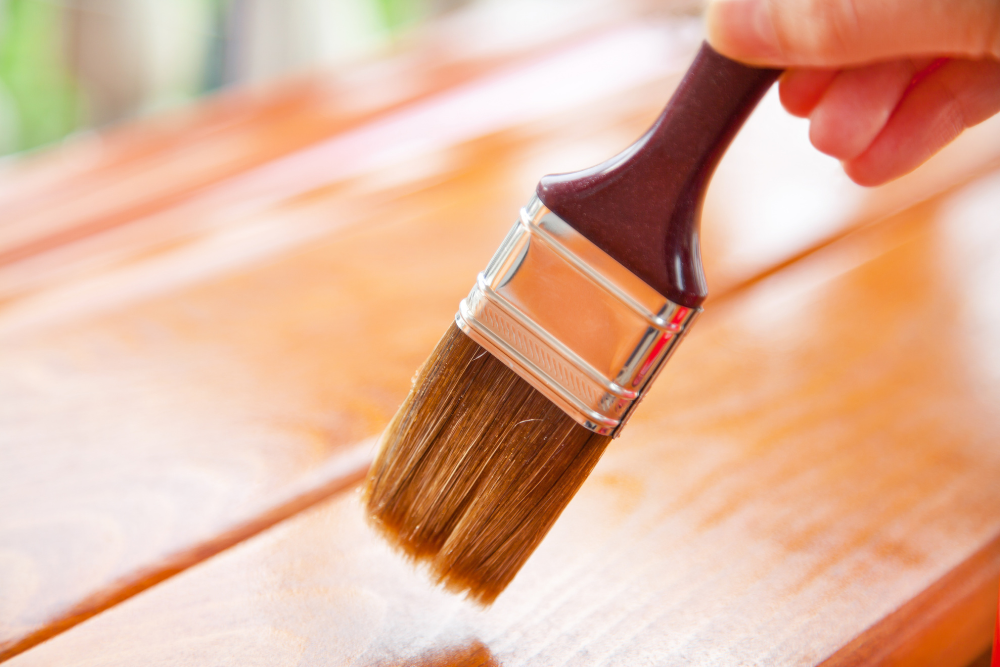Paint is made with various characteristics, each created with a different purpose of application.
There is no single best paint to use on finished wood as it depends on a variety of factors, such as the type of exposure it will be receiving or how much it is used.
Picking the right type of paint can ensure that your wood surfaces look entirely smooth, and that your paint will last for years to come.
Knowledge about the different types of paints available can help you figure out the best paint to use on finished wood.
Oil-based paint
This type of paint is where paint pigments are suspended in a drying oil, such as linseed oil. Since it contains oil as the solvent, this type of paint is typically slow-drying.
Many professional painters choose oil-based paint for its durability as the oil in the makeup of these paints helps to create a smooth surface when the paint is dry, which forms a nice glossy or satin finish that repels water and resists scratching.
As long as you have a high-quality paintbrush or paint sprayer to apply it, you will not require a topcoat because oil paints are naturally glossy, and create a luxurious appearance on their own.
Use this paint for:
- Kitchen or bathroom cabinets
These cabinets are exposed to a lot of moisture and grease, which is absorbed over time to a great degree by the average water-based paint. The moisture can build up and lead to the growth of mildew or mold on the cabinet surface.
Oil-based paint is both water-repellant and rot-repellant, which means it’s the best paint to use on finished wood cabinet painting.
- Floors
Oil-based paint can handle the daily toll from shoes and furniture relocations without denting or being damaged by water.
You might want to consider using alkyd-based oil paint rather than plant-oil-based paint, because the latter takes much longer to dry and will therefore be a little inconvenient.
- Standard trim
You are going to want to use oil-based paint for anything that is exposed to the elements, which includes any exterior trim.
You can also use this on interior trim, such as baseboards, door casings, or window and ceiling trim as these accumulate a fair amount of scuff marks and dents over time.
Oil-based paint can defend these areas more effectively than water-based paint.
- Furniture
Oil-based paints dry into a rigid layer over wood and continue to harden on the wood surface over time.
This can ensure that your wooden chairs, dining tables, and other frequently used furniture are less susceptible to scuff marks or dents.
Water-based paint
This type of paint consists of paint pigments and binders suspended in water as the carrier or solvent.
Water-based paints dry very quickly, which means that any painting project it’s used in can be completed much sooner.
These paints tend to be less durable than oil paints, though, so they aren’t always the best choice for exterior applications.
Use this paint for:
- Distressed furnishings
Chalk or milk paint is a type of water-based paint that is decorative and known for its elegant, shabby-chic look.
You can create a nice, vintage finish on wooden headboards, coat racks, or cupboards.
But, in general, you can use this paint on any surface that would benefit from a more distressed look.
Latex paint
Latex paint also contains water as a base, but dries slower than water-based paints as latex paint includes acrylic resin.
It’s a lot easier to use and clean latex paint than oil paint, but its resulting coat is less durable than oil paint.
You can choose from various sheen levels of latex paint, from matte and satin finishes to gloss and semi-gloss finishes.
The shinier the latex paint surface, the less likely you will need a topcoat.
Matte and satin finishes will require a topcoat as it makes the surface more durable and helps achieve a more upscale look.
Use this paint for:
- Furniture in dry areas
You can cover cabinets in the dry areas of your home with traditional latex paint as it is the most inexpensive and fast-drying option. It’s also a good choice for spaces where moisture isn’t a concern.
- Cabinets
Latex paints with a flat to satin sheen reflect less light than glossier sheens, which means that completely smooth coats can mask furniture flaws like knicks and scratches more effectively, which is good for cabinet shelves.
You can choose a semi-gloss or a high-gloss sheen for the cabinet exterior if you want to make lighter work of cleaning it.
- Ornate trim
Decorative trim can often have grooves that the thicker oil-based paints will have trouble reaching.
Latex paint can reach these groves and offer a more uniform paint coverage.
The best paint to use on finished wood depends on your wood
When you are choosing the paint to use on the various wooden surfaces around your home, it’s important to determine how often the surface is used and whether it is exposed to any harsh elements.
If you want a quick, high-quality job, a professional painter will be able to identify the best paint to use on finished wood depending on its use and location and deliver a good quality finish so that the paint will last for years to come.


Recent Comments